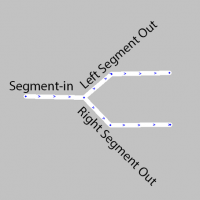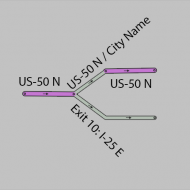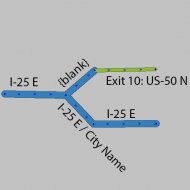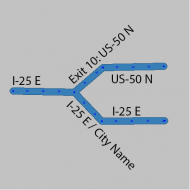Wayfinders
A wayfinder gives a user an instruction reminding them to stay on the road the user is already on, in situations where a reminder is warranted. A wayfinder is warranted in the following situations:
- Lane drops, where at least as many lanes leave the road as stay on the road;
- Non-obvious continuations, where at least one "exit only" lane exists on the side of the road where exits are not normally placed (in a right-hand traffic country, exiting traffic is to the left and continuing traffic is to the right); and
- Inconsistent signage, where a highway continues as a numbered route, but signs call it only by a name.
| Need sample images for "lane drops" and "non-obvious continuations"; also, example of BGS with lane arrows |

In these cases, we need to use a wayfinder configuration. Each wayfinder configuration will have one "IN" segment and two "OUT" segments.
Keep these basic principles in mind:
- The OUT segments must be the same type (either Freeway or Ramp, as explained below).
- Each OUT segment must have a name different than the IN segment.
- OUT segments should be named with the information displayed on the roadway signs.
- However, if this would leave an OUT segment with the same name as the IN segment, segment naming must be modified in one of the following ways in order of preference:
- Add a control/destination city, if it is known, to the OUT segment name.
- Remove the compass cardinal from the OUT segment name.
- Add a space to the end of the OUT segment name (note that this will be flagged by the WME Validator script, if active, and possibly result in undoing by another editor)
- Create a stub in the IN segment just before the junction with no street name.
- NOTE: This option should only be used as a last resort because it prevents the routing server from properly calculating turn delays, and may result in inefficient routing through the area.
- However, if this would leave an OUT segment with the same name as the IN segment, segment naming must be modified in one of the following ways in order of preference:
- Do not use "to" at the beginning of the name of the continuation segment (the user is already on the road, not going "to" it).
- Each "stub" segment should be 19.69 ft (6 m) long. This is long enough so it will not cause routing problems, but it is short enough to suppress display of the names (on Freeway stubs) and keep freeways looking contiguous (on Ramp stubs).
To configure the wayfinder,
- If the numbered/signed exit is on the right, the OUT segments should be Ramp type. This will give an "exit right" instruction for the exit and a "stay to the left" instruction for the continuation.
- For a basic exit, use a named Ramp stub for the continuation, and a standard Ramp for the exit.
- For a freeway split, use a Ramp stub on both sides.
- If the numbered/signed exit is on the left, the OUT segments should be Freeway type. This will give "stay to the" instructions on both sides (if Ramp segments were used, Waze would give a confusing "exit right" instruction for the continuation).
- For a basic exit, use a named Freeway stub for the continuation, and an unnamed Freeway stub followed by a named Ramp for the exit.
- For a freeway split, use named Freeway stubs on both sides.



